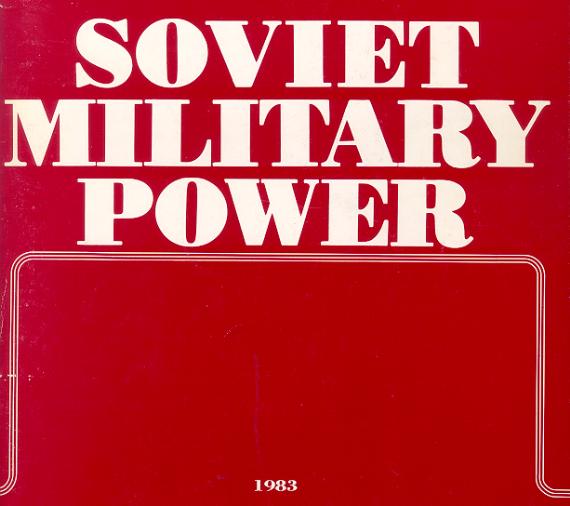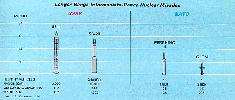 Soviet Military Power
Soviet Military Power Soviet Military Power
Soviet Military Power
The following text has been excerpted from Chapter III of Soviet Military Power 1983. This portion only contains information on missiles on the Soviet Western Theater.
In 1981, Soviet Military Power described Soviet theater forces by category. Soviet Military Power 1983 examines these forces as regionally deployed. For military purposes, the Soviets have divided Eurasia into three theaters: Western, Southern, and Far Eastern. Each theater has its own political and economic significance that determines Soviet military goals and objectives in the area and the strategy employed to achieve them.
The forces positioned for operations against NATO continue to be given the highest priority in receiving the newest and most capable systems. For example, since 1981 the Soviets have produced 4,500 tanks, including the T-80 deployed to forces opposite NATO. At the same time they have introduced new ground-attack aircraft and armored fighting vehicles into Afghanistan and are modernizing their forces in the Far East. This strengthening of forces is intended to enable the Soviets to achieve their political/military objectives as rapidly as possible with the most modern and capable theater forces, either through intimidation or direct military action.
A Renewed Concept for Combined Arms Combat: Capitalizing on their improved and modernized forces, the Soviets have reintroduced the World War II Mobile Group concept in the form of Operational Maneuver Groups(OMGs). OMGs are task-organized, self-sustaining, tank-heavy raiding forces constituting division- and corps-size formations at army andfront levels, respectively. Organized for commitment from the outset, OMGs would be expected to penetrate the enemy rear areas quickly and independently of the main body of forces.
The Soviets believe that successful OMG operations could severely disrupt the NATO rear area, thereby increasing the likelihood of maintaining a rapid advance without early resort to nuclear warfare. Operationally, the OMG would facilitate commitment of reinforcements by securing terrain over which additional Soviet forces must pass while hindering NATO's efforts to reinforce its forces. Additionally, although the OMG concept has been developed for conventional offensive operations, it is also well-suited for exploitation of nuclear strikes.
The Western Theater encompasses all of Europe. Because it contains those nations that possess a substantial portion of the world's wealth, technology, industrial capacity, and military power, it is the focal point of Soviet strategic planning. The Soviet goal in the Western Theater is to weaken the Atlantic Alliance to the point that it is no longer a viable military entity. In wartime, the primary Soviet objective would be to seize the initiative quickly and defeat NATO forces before they could be substantially mobilized or reinforced. To manage military operations against NATO, the Soviets subdivide the Western Theater into several Theaters of Military Operations (TVDs) - continental, oceanic and intercontinental - in which designated forces operate to achieve specific military objectives derived from political goals.
The Southern Theater encompasses Southwest Asia, to include the Arabian Peninsula. In this theater, Syria, Iraq, Iran and Afghanistan are of particular importance because of their proximity to the Soviet border and their location near Persian Gulf oil reserves. Moscow's long-range aim in the region is to establish itself as the dominant power at the expense of the West. To further this aim, the Soviets' policy is to modernize and strengthen their military capabilities, promote dependence upon the USSR, expand ties with sympathetic pro-Soviet elements, orchestrate anti-Western propaganda and obtain access to strategic port and air facilities in the nations of the Indian Ocean basin.
The Far Eastern Theater encompasses China, Japan, Korea and Southeast Asia. The Soviets' political goals are to improve relations with the PRC at the expense of US/PRC ties, to prevent Japan from increasing its contribution to Western security, to unify Korea under communist rule, and to expand Soviet influence in Southeast Asia. In the event of war, the Soviets would strive to control western and northeastern China, to preclude Japanese participation in a war in Asia and to defeat US and South Korean forces in Korea.
 Soviet forces in the Western Theater are those that pose the most direct threat to NATO and encompass all forces located primarily in the Western USSR and Eastern Europe. Soviet forces from other areas of the USSR can, of course, be shifted to combat against NATO.
Soviet forces in the Western Theater are those that pose the most direct threat to NATO and encompass all forces located primarily in the Western USSR and Eastern Europe. Soviet forces from other areas of the USSR can, of course, be shifted to combat against NATO.
The following review of the Soviet force modernization program for the Western Theater will show that the Soviets are balancing their conventional and nuclear forces to be able to fight a range of conflicts.
Soviet Intermediate-Range Nuclear Force(INF) Missiles: The Soviets will employ these systems to achieve strategic objectives within the theater. Since late 1977, the nuclear striking power of the Soviet Long-Range INF missiles has more than doubled, even though the total number of launchers has decreased. This marked increase in force capability is due to deployment of the SS-20 missile with its three, multiple, independently target able reentry vehicles (MIRVs). Today's LRINF missiles, consisting of 248 older SS-4 and SS-5 launchers, and more than 330 mobile SS-20s, can deliver an initial salvo of some 1,250 nuclear warheads. Of the total number of launchers, more than two-thirds are presently located within range of NATO, and nearly one-fourth of them have been deployed since 1981. The accuracy and reaction time of the SS-20 provide a marked improvement over the older systems. In addition, the mobility of the SS-20 greatly enhances survivability. Furthermore, each SS-20 unit is assessed to be equipped with refire missiles - one per launcher - and each refire missile also carries three warheads. Ground Forces: The full impact of improvements to Soviet ground forces opposite NATO must be viewed in the context of the total ground forces available. Out of the total of over 190 active divisions in the Soviet force, 94 are located opposite the Central and Northern regions of NATO. Another twenty divisions are located in the Transcaucasus and North Caucasus Military Districts; these divisions could likely be committed against Turkey or South west Asia. Some 16 additional divisions that can be allocated to combat operations in Europe constitute the Strategic Reserve and are centrally located. The six Warsaw Pact Allies of the Soviet Union have a total of 55 active divisions. In 1982, the NATO Allies in their force comparison counted a total of 173 USSR/Warsaw Pact divisions which could be mobilized against NATO. Today, that number has risen.
Since 1978, the Soviets have made major quantitative and qualitative advances in their ground forces. While technological improvements to hardware continue unabated through out the Soviet force, priority is given to the forces opposite NATO, enabling them to conduct rapid offensive operations, characterized by shock action, massive firepower and high mobility. These recent improvements in Western Theater ground forces are highlighted in the areas of surface-to-air, surface-to-surface missiles, tanks, artillery and helicopters.
Surface-to-Surface Missiles: Complementing the formidable array of intermediate and medium range systems, the Soviets are continuing to upgrade their tactical nuclear-capable surface to-surface missile force.
- The SS-21 is replacing the FROG-7 in the Western Theater. The SS-21 has a range of about 120 kilometers, 50 kilometers greater than the FROG-7, and it is more accurate, thus enabling greater targeting flexibility and deeper strikes.
- The SCUD, normally deployed in brigades at army and front level, is being replaced by the SS-23; a tactical surface-to-surface missile with improved accuracy and a range of 500 kilometers, versus the SCUD's 300 kilometers.
- Soviet SS-12/SCALEBOARD missiles, with a range of about 900 kilometers, are expected to be replaced by the SS-22 of similar range but greater accuracy.
Tactical Air Defense: The Soviets have developed a massive, layered air defense for their ground forces to provide air superiority over the battlefield. They have integrated frontal aviation, radio electronic combat, SAMs and associated radars and anti-aircraft artillery into an unparalleled tactical air defense system. Soviet tactical SAMs - SA-4, SA-6, SA-8, SA-9, SA-11, and SA-13 - shown on page 31 are mobile and are a functional part of ground force units at several levels of command. The ZSU-23-4supplements the SAMs and interceptors described below. These defenses will continue to be modernized in the future. Of particular note is the development of a new SAM with enhanced low-altitude capabilities and with the potential to defend against tactical ballistic missiles.